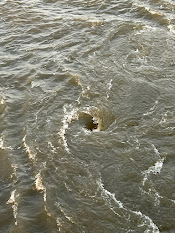Collapse
of Transmission Line Tower in River Kollidam
A
few days ago a power transmission tower founded in River Kollidam (which is a
branch of River Cauvery, and rejoining it further about 15 km to make the town
of Srirangam to call itself an island) collapsed; the proximate cause, I must
speculate was the surge in the water flow in the river, scouring the river bed
to catastrophic level.
The power line runs between the river banks, closer to the south bank of the river (the right edge in the photographs).But there are other such towers (110 kV, Double Circuit) founded in the riverbed more or less along a straight line and they did not collapse, as the top photo shows clearly. So, why only the tower shown above ? To answer this, I need to take you to an earlier post of mine here.
The important information is that the tower was
close to the check dam type of construction mentioned with a sense of
appreciation in the earlier post, failed leftwards and fell into the river.
Though I saw the tips of the arms of the tower the day after the failure,
unfortunately it did not strike me to take a picture then.
I am not the pied piper, to lead you into the river.
But, if you are interested (this is a technical matter but not beyond the reach
of a curious layman), you would read my earlier post.
In that post I had mentioned that the wall
constructed to reduce scouring around the foundations of the bridge has created a swimming
pool, though I was feeling uncomfortable as the wall was founded on possibly a layer not hard stones reaching only 15 meters below the river bed, I satisfied myself that the authorities
would have checked for the safety of the wall for the Highest High Water Level
flow under the bridge. I do not know whether this was done or not.
Yet, even if the wall was the culprit, you can see from the photographs below that there is a clear break and this must have been the first, preceding the others and in parts.
I must tell you that between the two end points of the breach, there were waves, not very high, yet giving a sea shore ambience. One passer-by commented that there are no reinforcement (obvious from the photos) and merely to humour him, I agreed. The failure is one of total shear failure and reinforcement would not have helped. The wall, under the force of the current merely sheared off at the weaker points along the wall. In the immediately above picture, one can see the sheer verticality of thebreak. If people who are experts in river hydraulics and also in disaster forensic may rebut or endorse my observations made without any supporting data.
I would be happy to learn. Even founding the wall
much deeper would not have helped, for the simple reason, the failure started
at the top. Once, the failure started, water finding the path of least
resistance would have flown more and more ferociously causing the subsequent
failures, with or without reinforcement.
But, what do I know?
Yet, the post is not over. There is one ore small
item. A letter sent to the Tiruchirappalli edition of the newspaper The Hindu and appearing in the Letters
to the Editor or Reader’s Mail is given below. I have edited out the name of
the writer, for his sake as well as mine!
The design of the wall must have been certified by a
government authority at the appropriate level ... yet, the designer would be
held responsible for any failure. I know because I was working for a design
consultant and the company lost a huge amount of money for a failure, and note
– not a design failure, but during construction (centring truss) .
The contractor takes his Measurement Book, each page
attested to by the site-supervisor of the government, raises a part bill (if it
is allowed in the contract) and only then any payment will be released. Only if
the design is done in-house (by the government authority), would the case come
to the contractor. We talk often about running from pillar-to-post due to the
all-entangled bureaucracy, and I have merely pointed out what are these, in
general terms.
The surprise is that the paper published this!
I do not wish to say that it was “An Act of God!” Yet, it is one, ask Lord Ranganathar.
Yet, I am not finished. Out of interest, I read up on black holes and watch videos on YouTube in astro physics, whether I understand it or not at the level intended by the speaker/presenter. As I do not think I am a complete idiot (though your free to think so), the photo below gives a layman about an astral black hole gobbling up any material coming too close for its (the material) comfort. It gets gobbled up. And, this is something physicists do not agree with, as they feel strongly that information cannot be destroyed! So, they think that somehowthat falls into a black hole leaves a hologram. Look at the following picture.
The dark spot in the middle of the photograph is precisely the equivalent of the black hole in astronomy, except for that it is not at one place; it vanishes as fast as it appears elsewhere and I just took many photos in which I got one whirlpool, yes that is what we call a hydraulic black hole! We can notice at least one arm of this whirlpool.
Raghuram Ekambaram








No comments:
Post a Comment